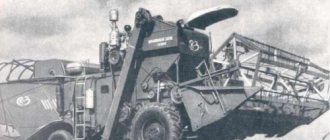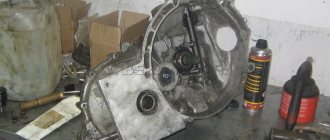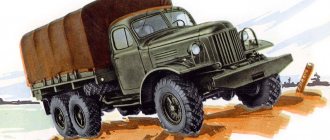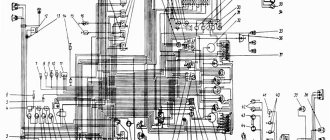The GAZ-63 all-terrain vehicle became the first Soviet car with all-wheel drive, produced in series. The car, together with the ZiS-151, formed the basis of the Soviet Army's vehicle fleet in the first post-war decades. The truck was produced in North Korea under the name Sungri-61 and in China under the designations Yuejin NJ230 and NJ230A.
The vehicle, which had an excellent reputation in the army, was completely unsuitable for civilian service. The overloaded engine could not cope with the work, choking when operating at full power, and when using the carrying capacity to the maximum, the all-terrain vehicle lost its main advantage - cross-country ability.
History of the model
The development of a promising generation of trucks began in 1937. The project envisaged the creation of the most unified vehicles - a civilian truck with rear axle drive and an army vehicle equipped with all-wheel drive. The new generation of trucks was radically different from the GAZ-AA.
The first prototype of the GAZ-63 appeared in the spring of 1939, several months ahead of its civilian counterpart. The car became the first car with all-wheel drive built by GAZ. The all-terrain vehicle used a 76-horsepower Dodge D5 engine and an original transfer case that could disconnect one or both axles. The outbreak of the Great Patriotic War interrupted the testing of the machine, but work to improve the design did not stop.
The further development of the vehicle was influenced by American and English trucks supplied under Lend-Lease.
Modernized prototypes of the GAZ-63 all-terrain vehicle were tested in 1944 and were equipped with a modified cabin modeled after the American Studebaker.
Serial production was planned to begin in 1945, but due to technological difficulties it had to be postponed to 1948.
The first cars rolled off the assembly line in early autumn. At that moment, hardly anyone imagined that the all-terrain vehicle would remain in production for 20 years and sell almost 475 thousand copies.
Design Features
The GAZ-63 all-terrain vehicle is built on a frame chassis. The layout provides short front and rear overhangs, which has a positive effect on the geometric cross-country ability of the GAZ-63. The design uses tires with the ability to operate at reduced pressure; it is worth noting that this significantly reduced the rubber service life. The wheels were inflated while the engine was running.
To ensure quick start-up, the GAZ-63 radiator had a flame pipe into which a blowtorch was inserted.
The lamp installation location was located in the right front wheel arch. When the lamp was operating, the liquid in the radiator was heated by the flame, and the hot air heated the oil in the engine sump of the all-terrain vehicle.
Body
The military GAZ-63 was equipped with a wooden universal body, which had high lattice side sides and a front wall. Inside there were folding longitudinal benches. The tailgate was also made to open. The side boards had special sockets into which arcs could be installed to tension the awning.
Based on the requirements of the military leadership, the designers increased the capacity of the fuel tanks. A 105-liter tank was added to the main ninety-liter tank, which made it possible to increase the fuel volume to 780 kilometers at full load.
Machine structure
To install the components of the GAZ-63 all-terrain vehicle, a frame assembled from a steel profile with rivets is used. The side parts of the frame consist of variable profile spars. The cross members are riveted to the side members, except for the second one, on which the engine mounts are located. This engine support beam is removable and bolted on.
The front part of the frame ends with a buffer, on the top of which there are two tow hooks. The rear cross member is equipped with a standard towing mechanism with a spring shock absorber.
Engine
The GAZ-63 all-terrain vehicle uses a 70-horsepower carburetor engine of the GAZ-21 model as the power unit. The engine has 6 cylinders arranged in a row. Gas distribution system with lower valves. Cooling system with forced circulation of liquid from a centrifugal pump. GAZ-21 was designed to run on gasoline with an octane rating of A-66.
Fuel is supplied by a diaphragm pump that supplies gasoline from a tank with a capacity of 90 liters.
The tank is installed between the frame side members under the cab. In early versions of the all-terrain vehicle, the fuel supply was stored in a 105-liter tank located under the platform on the left side member of the frame. After 1949 this tank became optional.
Fuel consumption on onboard GAZ-63 all-terrain vehicles was up to 25 liters per 100 km (only 5 liters more than the civilian GAZ-51). The truck tractor, due to the greater weight of the road train, consumed 35 liters per 100 km.
Transmission
The engine on the early GAZ-63 all-terrain vehicles is equipped with a semi-centrifugal clutch, equipped with one dry friction working disc. Later, a conventional single-plate clutch was used, which ensures uniform pressure on the discs throughout the entire speed range.
All-terrain vehicles were equipped with one type of manual gearbox, which provided 4 gears for forward movement. Top gear is direct. The gearbox design uses straight tooth gears.
Torque distribution is carried out using a separate gearbox. The box is connected to the gearbox by a cardan shaft. The GAZ-63 transfer gearbox has forward and reducing speed, and also provides the ability to disable the front axle drive.
The transfer gearbox of the all-terrain vehicle is connected to axles with standardized cardan shafts.
The shaft between the transfer case and the gearbox has the same geometric dimensions. The shafts do not have intermediate supports and are equipped with splined connections that allow movement of the transmission units.
The axles of the GAZ-63 car have completely unloaded axle shafts. The gearboxes are interchangeable and equipped with bevel main pairs with a spiral tooth. The gear ratio is 7.6. Bevel differentials are installed in the axle housings. There is no center differential mechanism on the all-terrain vehicle. The front axle axle shafts are equipped with steering knuckles with Bendix-Weiss-type ball joints.
Auxiliary drives
Early releases of the GAZ-63 all-terrain vehicle were equipped with a 1-cylinder air compressor designed to inflate tires. The compressor was mounted on the box housing and was driven by a stray shaft. Later, the compressor was abandoned; for pumping, a device was used that was screwed into the spark plug well of the engine cylinder.
The GAZ-63A all-terrain vehicles were equipped with a winch driven by a separate power take-off. The box had 3 speeds and was located on the side surface of the gearbox housing. A cardan drive was installed between the winch and the output shaft.
The take-off box provided reduced and increased speeds for pulling the cable onto the drum and one speed for unwinding the cable. The engine power was enough to provide a thrust force of 3500 kg.
A similar take-off box was used on GAZ-63D truck tractors, only the output shaft was directed backwards.
The box was used to operate the tipping drives of the GAZ-707 dump semi-trailer. Since the mid-50s, a simplified selection box began to be used, which had one speed forward and backward. The latest versions of all-terrain vehicles were equipped with a selection box unified with the unit from the GAZ-66.
Steering
The GAZ-63 all-terrain vehicle is controlled using mechanical control. The steering shaft is connected to a worm shaft installed in the gearbox. The shaft has a globoid profile. A double-ridge roller, connected to the output shaft, moves along the cutting.
At the output of the gearbox there is a bipod, which turns the wheel using a rod. An additional transverse rod is installed between the wheels, ensuring synchronized control operation.
Early GAZ-63 all-terrain vehicles were equipped with a three-spoke steering wheel with a diameter of 450 mm; later it was changed to a steering wheel with a diameter of 425 mm.
Brake system
The machine's service brakes are installed on all wheels and are of the drum type. The mechanisms were driven by a hydraulic system that did not have an amplifier. Early GAZ-63 all-terrain vehicles used a disc parking brake. The blocks were fixed using a lever installed on the cabin floor.
Since 1956, a mechanically controlled drum mechanism began to be used.
Due to their greater mass, the GAZ-63P and 63D truck tractors were equipped with a hydraulic vacuum booster in the brake drive circuit, as well as an enlarged master brake cylinder.
Cabin
Early versions of the GAZ-63 all-terrain vehicle had a combined cabin design. The frame, front tail, windshield frame, instrument panel and side door frames were made of metal. The rear of the cabin and door panels are made of wood and topped with thin plywood.
Because of this, the rear of the cabin has a characteristic flat shape. There is an observation window on the wall, covered with a protective mesh. The roof of the cabin had a wooden frame on which leatherette or tarpaulin was stretched.
For ventilation, the windshield frame could be tilted up. The doors did not have rotating windows, but were equipped with roll-down windows. To clean the windshield there was a single wiper driven by a vacuum mechanism.
The drive operated from a vacuum in the engine intake manifold, so the intensity of cleaning depended on engine speed.
A characteristic feature of the early GAZ-63 all-terrain vehicles is the lack of heating in the cabin, as well as wooden running boards.
Since 1949, the introduction of transition cabins of an all-metal structure with a rounded rear part began. The outer surfaces had a edging of steel strips secured with screws. Dirt-proof aprons equipped with two stampings appeared under the doors.
The running boards of the GAZ-63 all-terrain vehicle began to be made of metal. Wooden parts continued to be used in the door construction, but the doors were sheathed on the outside with steel sheets. A cabin of this design was used until the end of 1957, after which an all-metal structure began to be used. Externally, the cabins are distinguished by rounded side glass frames and opening windows.
At the same time, the side panels of the hood were changed - instead of the inscription “Avtozavod im. Molotov" the text "Gorky Automobile Plant" appeared. Cabs of the transitional and late type were equipped with a heating system and two vacuum-driven glass cleaners.
The interior of the GAZ-63 cabin remained constant, only the quality and finishing materials changed. The seats for the passenger and the driver are separated, between them there is a gearbox column with a gear shift lever. The driver's seat was adjustable in the longitudinal plane. The battery was located under the driver's seat; until 1960, it was located in a special mount on the left side member of the car frame.
Suspension
The GAZ-63 all-terrain vehicle is equipped with a dependent suspension on leaf springs. The kinematics of the suspensions are unified - the rear end of the spring is mounted on a swinging shackle, which compensates for changes in the length of the unit. The front suspension uses lever shock absorbers that operate in compression and rebound.
The rear springs of the car are equipped with additional springs.
On army and some civilian vehicles, 18x8 wheels were used, with split side and lock rings. Truck tractors based on the GAZ-63 were somewhat different in this regard; they were equipped with wheels from the GAZ-51.
Loading platform
The GAZ-63 onboard all-terrain vehicle was equipped with an onboard cargo platform made of wood and located on the frame behind the cabin. Loading and unloading was carried out through the folding rear side of the body.
The side boards could be increased by installing grids on top of boards, knocked together according to certain standard sizes. The platform was installed on the frame using timber sheathing. In the back, along the sides, there were folding benches designed to accommodate 12 people.
Body dimensions of the GAZ-63 all-terrain vehicle:
- length – 2940 mm;
- width – 1990 mm;
- height of sides (side and front) – 890 mm;
- loading height – 1285 mm.
The folded tailgate of the GAZ-63 was held horizontally by chains and served as a continuation of the platform floor. There were folding steps on the edge of the side, making access to the platform easier. On the sides there are brackets for fastening four removable arches. Under the floor of the all-terrain vehicle platform there are two spare parts boxes and a can for 10 liters of motor oil.
Since 1953, the front side began to be equipped with two yellow reflectors, and the rear - two red reflectors. Reflectors were used on the all-terrain vehicle for 10 years, until the introduction of plastic lenses on the external lighting equipment of the GAZ-63.
Brake system and clutch
The GAZ-63 was equipped with a single-plate dry clutch. A hydraulically driven shoe unit was used as a service brake for all wheels. The parking brake was of the drum type and had a mechanical drive.
The suspension on all wheels was dependent and was installed on semi-elliptical springs. At the same time, the front suspension was equipped with double-sided hydraulic shock absorbers. The steering mechanism included a double-ridge roller and a globoid worm.
Specifications
| Parameter | GAZ-63 | GAZ-63A | GAZ-63P |
| Load capacity on the highway and on the ground, kg | 2000 and 1500 | 4000 and 3000 | |
| Trailer weight, kg | 2000 | Not used | |
| Length, mm | 5525 | 5800 | 4950 |
| Width, mm | 2200 | 2110 | |
| Height, mm | 2245 | 2220 | |
| Base, mm | 3300 | ||
| Curb weight, kg | 3200 | 3440 | 2783 |
| Speed, km/h | 65 | 55 | |
Modifications
The plant produced several modifications of the all-terrain vehicle:
- GAZ-63 – basic version;
- GAZ-63A – basic version equipped with a 4.5 t winch;
- GAZ-63E and 63AE - military vehicles with shielding of electrical networks and equipment, the AE model was equipped with a traction winch similar to that installed on the A model;
- GAZ-63U and 63AU - export versions, distinguished by quality of workmanship and finishing;
- GAZ-63Yu and 63AYU - cars designed for operation in tropical climates, additional engine cooling and additional filters are installed;
- GAZ-63P and D are truck tractors on a basic basis.
Civilian chassis of the GAZ-63 were used to create fire tanks of the ATSU-20 and PMG-19 models, the AR-1.6 hose vehicle and the ASOP-5 communications vehicle. In civil service, the ATZ-2.2 tank for petroleum products and the ATs-18 and VTsPT-1.5 tank for dairy products were actively used.
The GAZ-63 chassis and flatbed truck were widely used in the Soviet Army. On the basis of the all-terrain vehicle, a TZ-63 fuel tanker, an MZ-3904 oil carrier, an AS-1 medical van, a platform for transporting a light pontoon fleet, and mobile radio stations were mounted. The 17-barrel rocket launcher BM-14-17 was produced in small series. Truck components were used to create the BTR-40 armored personnel carrier and the BRDM-1 amphibious vehicle.
A small batch (no more than 9 pieces) of PAZ-654 staff buses was produced for army needs.
The salon was equipped with tables and places for staff, rigidly fixed to the floor. There was radio equipment, racks for storing weapons and additional means of extinguishing fires.
On the outside of the body there was a ladder used when installing antennas. The bus interior was equipped with an additional heater. The car did not reach series production due to low stability and chassis overload.
Based on the all-terrain vehicle, the AS-3 ambulance bus was produced, intended for transporting the wounded or sick, as well as medical equipment. The all-metal van could accommodate seven bedridden patients and two seated patients. When transporting only sedentary patients, the capacity increased to 14 people. For construction, a bus chassis was used, equipped with shock absorbers on the rear axle and spring leaves with reduced rigidity.
A trace in the history of the automotive industry
The GAZ-63 all-terrain vehicle became the basis for the creation of light armored personnel carriers BTR-40 and BRDM-1, which were a new type of weapon for the Soviet Army and were mass produced for almost 10 years.
The development of the famous GAZ-66 “shishiga” would have been impossible without the experience of operating the GAZ-63 army all-terrain vehicles.
The data obtained made it possible to improve the design of the new army vehicle and improve its performance characteristics.
To date, the operation of GAZ-63 vehicles continues. All-terrain vehicles are used both for delivering goods in off-road conditions and as expeditionary vehicles. Copies from the first years of production have collector's value.
Historical reference
The development of this truck began in the pre-war period, in 1938. During the era of World War II, American trucks were assembled at the Gorky Automobile Plant based on various parts supplied from the United States, but the design of a domestic off-road vehicle did not stop for a minute. And in February 1943, designer Lipgart reported to Stalin about the creation of the GAZ-63 all-wheel drive vehicle. After this meeting, the engineer received the go-ahead from the state leadership for the post-war production of the machine.











